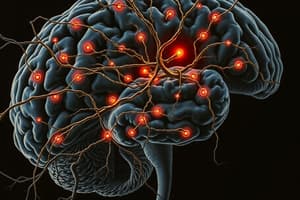Podcast
Questions and Answers
The central nervous system includes the ____ and the ______.
The central nervous system includes the ____ and the ______.
brain and spinal cord
What does the peripheral nervous system include?
What does the peripheral nervous system include?
All the nerve fibers outside the brain and spinal cord, including 12 pairs of cranial nerves, 31 pairs of spinal nerves and all their branches.
The cerebral cortex is the center for?
The cerebral cortex is the center for?
A human's highest functions, governing thought, memory, reasoning, sensation and voluntary movement.
What is the frontal lobe responsible for?
What is the frontal lobe responsible for?
What is the parietal lobe known as?
What is the parietal lobe known as?
What is the occipital lobe responsible for?
What is the occipital lobe responsible for?
What functions does the temporal lobe serve?
What functions does the temporal lobe serve?
Where is Wernicke's area located and what is its function?
Where is Wernicke's area located and what is its function?
What is Broca's area associated with?
What is Broca's area associated with?
Which of the following areas are parts of the central nervous system?
Which of the following areas are parts of the central nervous system?
What is receptive aphasia?
What is receptive aphasia?
What is expressive aphasia?
What is expressive aphasia?
What does the basal ganglia help with?
What does the basal ganglia help with?
What is the thalamus?
What is the thalamus?
What are the main functions of the hypothalamus?
What are the main functions of the hypothalamus?
What does the cerebellum help with?
What does the cerebellum help with?
What three areas comprise the brainstem?
What three areas comprise the brainstem?
What does the left cerebral cortex receive?
What does the left cerebral cortex receive?
The sensation travels in the afferent fibers in their peripheral nerve, through the posterior (dorsal root) and into the spinal cord. Once at the spinal cord, it may take one of two routes: _______ or _______.
The sensation travels in the afferent fibers in their peripheral nerve, through the posterior (dorsal root) and into the spinal cord. Once at the spinal cord, it may take one of two routes: _______ or _______.
What does the spinothalamic tract do?
What does the spinothalamic tract do?
What do the posterior (dorsal columns) do?
What do the posterior (dorsal columns) do?
What does the corticospinal (pyramidal) tract allow?
What does the corticospinal (pyramidal) tract allow?
What do the extrapyramidal tracts contain?
What do the extrapyramidal tracts contain?
What do the extrapyramidal tracts do?
What do the extrapyramidal tracts do?
Describe the job of upper motor neurons (UMN).
Describe the job of upper motor neurons (UMN).
Flashcards are hidden until you start studying
Study Notes
Central Nervous System (CNS)
- Comprises the brain and spinal cord, which are responsible for processing and transmitting information.
Peripheral Nervous System (PNS)
- Consists of all nerve fibers outside the CNS, including 12 pairs of cranial nerves and 31 pairs of spinal nerves.
Cerebral Cortex
- Responsible for the highest human functions such as thought, memory, reasoning, sensation, and voluntary movement.
- Divided into four lobes: frontal, parietal, occipital, and temporal.
Lobes of the Cerebrum
- Frontal Lobe: Governs personality, behavior, emotions, and intellectual functions.
- Parietal Lobe: Acts as the center for sensation.
- Occipital Lobe: Serves as the primary visual receptor area.
- Temporal Lobe: Functions as the auditory reception center, involved in hearing, taste, and smell.
Language Centers
- Wernicke's Area: Located in the temporal lobe, related to language comprehension; damage leads to receptive aphasia, where sounds are heard but have no meaning.
- Broca's Area: Found in the frontal lobe, mediates motor speech; damage results in expressive aphasia, where the individual cannot speak properly but understands language.
Additional Brain Structures
- Basal Ganglia: Initiates and coordinates movements and controls automatic associated movements.
- Thalamus: Acts as the main relay station for sensory pathways from the spinal cord and other areas.
- Hypothalamus: Serves as a major respiratory center and regulates vital functions like temperature, heart rate, and appetite.
- Cerebellum: Located under the occipital lobe, responsible for motor coordination, equilibrium, and muscle tone.
- Brainstem: Contains the midbrain, pons, and medulla, playing crucial roles in autonomic functions like respiratory and heart control.
Cerebral Hemisphere Functions
- The left cerebral cortex controls the right side of the body and receives sensory information from it, while the right cerebral cortex does the opposite.
Sensory Receptors
- Millions of sensory receptors are distributed in the skin, mucous membranes, and deeper structures, monitoring sensations, organ function, body position, and reflexes.
Sensory Pathways
- Sensation travels via afferent fibers in peripheral nerves to the spinal cord, taking routes through either the spinothalamic tract or posterior (dorsal) columns.
- Spinothalamic Tract: Transmits sensations of pain, temperature, and light touch.
- Posterior (Dorsal) Columns: Conduct sensations of proprioception (awareness of body position), vibration, and localized touch.
Motor Pathways
- Corticospinal (Pyramidal) Tract: Facilitates skilled, purposeful movements.
- Extrapyramidal Tracts: Contain motor fibers that maintain muscle tone and control gross automatic movements such as walking.
Upper Motor Neurons (UMN)
- UMNs are located entirely within the CNS and play a critical role in controlling voluntary movements.
Studying That Suits You
Use AI to generate personalized quizzes and flashcards to suit your learning preferences.



